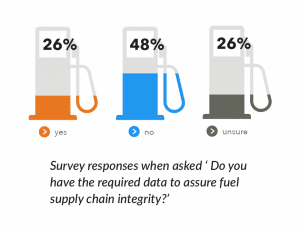Author: authentix
Brand Protection: Select the Right Partner White Paper – Thank You
|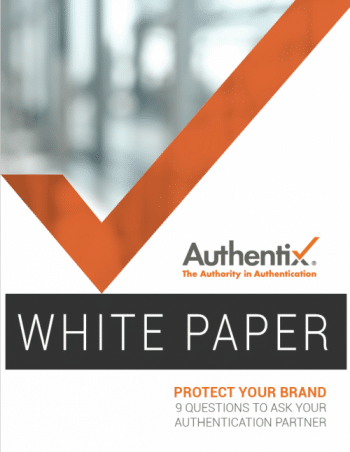
Thank you for your interest in our white paper.
To learn more about how we can help you combat counterfeiting, visit us here.
If you are interested in talking to us now, click here.
Advanced Technology: Informing & Empowering Fuel Authentication Programs
|The financial impact of fuels stolen or adulterated every year is estimated to be over $133 billion, creating fuel manipulation and fraud concerns for commercial fuel companies and government agencies. Fuel manipulation has a significant impact on branded fuel companies, decreasing revenue and threatening brand reputation and competitive advantage. Similarly, fuel fraud affects governments through lost tax revenue and the exploitation of subsidies. These concerns can be mitigated through advanced technologies for fuel markers, devices and the resulting data and analytics.
Methods of Fuel Manipulation
“The financial impact of fuels stolen or adulterated every year is $133 billion.”Ernst & Young Fraud Report on Oil & Gas, 2017
While fuel manipulation can occur accidentally through equipment failures or human error, it is most often an intentional act of adulteration, substitution, diversion or smuggling.
ADULTERATION — adding a lower quality product to the fuel in an attempt to increase profits. Adulterants may include:
- Lower taxed or subsidized fuels
- Inferior products (e.g., waste oil, solvents)
- Lower grade products
- Stolen petroleum products
SUBSTITUTION — substituting one product for another and misrepresenting its quality or classification to sell for a higher price, typically non-branded or differentiated fuel sold as premium.
DIVERSION/SMUGGLING — diverting product from the intended supply chain and recipient as it crosses various points in the supply chain, including national and state boundaries or between control points. Transport is one of the biggest risks in fuel supply chain management:
- Subsidized products are diverted during transport and sold as premium
- Fuels are smuggled to higher priced markets
Fuel Markers, Devices & Analytics: The Technology Behind Fuel Authentication
An effective fuel authentication program uses advanced technologies to help governments and commercial fuel companies improve operations, increase revenue, diminish toxic emissions and protect the integrity of fuel in the supply chain. The concept is simple − by adding a unique marker, the fuel obtains a unique fingerprint. Using the appropriate analyzer, the fuel is then identified as legal or adulterated.
Fuel markers are used to distinguish different types or brands of fuel and can take different forms, each serving a specific purpose. For example, markers injected into the fuel can allow for end-to-end supply chain tracking. When the fuel reaches its destination, quality control processes test for markers to ensure the supply chain hasn’t been disrupted and the fuel isn’t compromised. Quality control testing can take place in the field (station or terminal) with handheld or mobile devices or in a laboratory setting, depending on the needs of the organization.
OVERT VS COVERT — Overt markers are typically colored dyes that are visible to the eye and may be imitated or replicated. Covert markers, on the other hand, can only be identified by a highly sensitive detection device. At Authentix, we develop and employ only proprietary and unique covert markers to ensure the highest security and effectiveness.
RECOGNITION, OPTICAL AND MOLECULAR — Authentix offers three different categories of covert markers which vary in complexity and use.
- Recognition markers are captured by custom-matched antibodies and are then detected by a reader or test kit. Detection can be in the field (qualitative) or laboratory (quantitative). Industry accepted and commercially proven, these markers provide a substantial barrier to entry and use low marking levels.
- Optical markers use covert organic chemicals that emit a detectable fluorescent light when excited and are visible only with a highly sensitive field detection device that provides near-instantaneous results.
- Molecular markers exploit the unique mass spectrum of chemical entities, enabling lab-based qualitative and quantitative analysis. The forensic lab device used by Authentix is a customized gas chromatography mass spectrometer (GC-MS), the globally recognized gold standard for court-defensible forensic analyses.
FIELD VS LABORATORY — Devices and analyzers can vary in the types of results produced, as well as the location the analyses occurs. In the field, for example, Authentix uses handheld devices and mobile applications that are easy to use and can collect large amounts of data quickly that is then uploaded to an information system. The Authentix Information System (AXIS®) rapidly produces actionable insights that flag suspicious results, increasing the chances of preventing future manipulation. Lab-based testing is often used if a fuel sample collected in the field produces a ‘failed’ or ‘suspect’ result. Conducted under strict guidelines, this testing can provide excellent forensic analysis or confirmation.
Key Considerations of Fuel Protection Programs
QUALITATIVE VS QUANTITATIVE
A qualitative analysis is used to quickly verify the presence of a marker by producing yes/no results. A quantitative analysis provides additional insight into an amount (percent) of dilution or adulteration that may have occurred. Authentix works with its customers to determine the need for instantaneous results or more detailed results, or in some instances, both.
PORTABILITY
Manipulation and fraud decrease dramatically when overseers are in place, enabling real-time enforcement. Authentix can deploy teams equipped with user-friendly devices into wide geographic areas to serve as an effective deterrent.
ENVIRONMENTAL COMPLIANCE
Fuel authentication programs can also help decrease the impact fuel manipulation can have on the environment and public health. As a rule, all Authentix markers comply with the United States Clean Air Act, comprising carbon, hydrogen, oxygen and nitrogen (CHON) which allows marked fuels to retain their performance specifications, emissions characteristics and environmental compliance.
PROPRIETARY VS PATENTED MARKERS
When choosing a program, it’s important to know if the solution uses patented or proprietary markers. When applying for a patent, for example, the composition of the markers is accessible to anyone who wishes to detect or replicate them. To further increase marker security, Authentix only uses proprietary markers that are confidential and virtually impossible to reverse engineer.
DATA & ANALYTICS
A monitored and digitized fuel integrity program provides useful data to mitigate the risks of fuel moving through the supply chain. Using AXIS®, Authentix collects and analyzes data from different applications and disparate data sources. Insights gained help anticipate future challenges, identify new threats and accelerate detection, providing a significant competitive advantage through predictive analytics.
Authentix. The Authority in Authentication.
Working with governments, central banks and commercial companies, Authentix provides custom authentication solutions tailored to meet specific business challenges. Our core capabilities in developing and manufacturing proprietary chemical markers, designing analytical instruments and devices, and applying interdisciplinary chemometric models are enhanced by data integration, analytics and program management.
With over 25 years of experience in government and commercial fuel authentication, Authentix helps ensure local economies grow, banknote security remains intact and commercial products have robust market opportunities. Visit www.authentix.com.
Digital Advancements Improve Fuel & Data Integrity — And Answer Tough Supply Chain Questions
|Fuel integrity failures lead to significant revenue losses, brand damage, environmental pollution, poor vehicle performance and increased consumer complaints. To avoid these industry challenges, many branded fuel companies and government agencies are implementing fuel authentication programs throughout the supply chain. As more of these programs are implemented worldwide, stakeholders are finding significant return on investments as fuel quality is greatly improved, revenue and tax collections increase, and the overall integrity of the downstream supply chain is confirmed.
Digital Transformation in the Fuel Supply Chain — Right Data, Right Time
“Digital transformation in fuel authentication programs such as Wi-Fi-enabled mobile devices that communicate directly with our data analysis and reporting platform, AXIS®, can reduce data collection and reporting time in the field by 50 percent or more. The automated data uploads increase the speed and accuracy of data entry, eliminating errors resulting from manual processes used in the past.”Jeff Conroy, Chief Technology Officer, Authentix
The responsibility of managing the complex fuel supply and distribution chain falls on multiple stakeholders within a commercial brand or governmental agency. The value added through a reliable flow of accurate and timely data provides actionable insight for these stakeholders to measure and reconcile information quickly and enforce, react and remediate fuel fraud. In national fuel integrity programs for example, the agencies responsible for the collection of fuel excise taxes use data analytics to quickly detect the introduction of illicit fuel in the supply chain and, through fast enforcement action, increase tax collections and provide tremendous societal benefits.
Additionally, reliable digital data flow enables branded fuel owners to answer critical business questions about their downstream retail operations. Using a fuel marking program, coupled with digital data analytics, can ensure that premium additized fuel products are being distributed correctly under the right brand retail operations.
“Only one in four (25%) professionals believe they have the data needed to assure their brand’s fuel integrity.”Downstream Fuel Manipulation: The threats that could cost you, Oil & Gas IQ, 2018
Authentix has been a pioneer in combining physical fuel marking programs and the collection and automated analysis of supply chain data, and it has led the way on this digital transformation.
Advancements in digital technologies have made fuel authentication programs and the resulting data analytics easier to collect, secure and provide both enterprise and mobile reporting capabilities for its customers, driving improved supply chain security and integrity. Instead of gathering, entering and storing data manually, as in the past, Authentix field inspectors use portable, handheld analyzers digitally connected to the cloud. These advanced mobile
devices record supply chain data and communicate directly with our cloud-based data analysis and reporting platform, AXIS® (Authentix Information System).
The slow collection and reporting velocity of manually supplied data greatly increases the risk of fuel manipulation. Today, with advances in mobile or electronic telemetry data collection technology, AXIS® can enable users to quickly correlate fuel supply chain data with other correlated data from field devices and lab-based results for rapid response capability. For over 20 years, Authentix has been executing data reporting for our customers in real-time, analyzing supply chain results and creating actionable insights for improved program management and decreased opportunities for fuel manipulation or adulteration.
How Does AXIS® Work?
AXIS® is an integrated set of software applications designed to aggregate, store, analyze and present data from multiple and disparate sources to solve for potential supply chain integrity problems. Accessible through a remote web application, the system also presents dashboards and user-configurable reports to enable data-driven decisions and confident actions. Collected data could include geolocation, date and time of collection, retail or terminal IDs, and other identifiers and contextual data.
These identifiers ensure data integrity by establishing a chain of custody and providing contextual informa- tion to ingest and analyze. The correlation and analysis processes generate alerts and insights to ensure any needed revisions and optimization. For example, contextual data (e.g., truck tracking, bills of lading, retail pricing, etc.) provides insights beyond simply providing fuel integrity confirmation. It can also help determine how, when and where fuel supply chain fraud has occurred.
The insights and analytics provided by a robust information system like AXIS® can help prevent supply chain interruptions, program stoppage and lost revenue, while employing strict cybersecurity controls to ensure IT environment security. By generating answers and recommended actions through data analytics, AXIS® helps commercial brand owners and governments better understand and secure their fuel supply chains for the long-term.
Understanding Your Fuel Supply Chain
- What has happened? Historical data is gathered — including store and terminal IDs, and date and time stamps — and correlated with similar data. Through data analysis, patterns and anomalous behavior become evident, potentially indicating manipulation or fraud. These descriptive insights are used to flag those incidents.
- Why did it happen? Diagnostic insights from sales and supply chain data can help determine how a retail location received illegal or illicit fuel and point to specific transactions and individuals involved. Using that data, AXIS® can help users ascertain if all the non-compliant retail stations in a designated region received their fuel from the same terminal, implying that the exceptions noted could be quality control problems and not fraud. Data such as temperature and voltage records also help field inspectors monitor portable device performance, flagging potential servicing requirements that may be needed.
- What will happen? Authentix is accelerating digital transformation for customers with a focus on advancing predictive analytics capabilities. For example, AXIS® can correlate and analyze program data and other external data sources to spot patterns and anomalous behaviors. This provides unique insight into new threats and accelerates detection and learning to provide a significant competitive advantage.
- Can it be repeated? Prescriptive insights can help define possible actions needed to prevent fraud, enabling branded fuel companies and governments to create processes and improve supply chain management.
Leveraging Data Analytics to Drive Actionable Insights
Organizations often discover illicit fuel in certain markets, such as tax-evaded fuel sold as premium or transit fuel outside of an intended designated region. Comprehensive, end-to-end fuel authentication programs — from marker injection at the terminal down to field or lab testing results, and data analytics and resulting actionable insights — empower organizations to discover the origin of illicit fuels and prevent these events from happening in the future. By providing contextual information, Authentix fuel authentication programs help pinpoint trouble spots in the fuel supply chain that would not be discovered through normal security audit processes. With the technology to collect, upload and aggregate data using portable web-based devices, the workflow becomes truly automated, assuring greater fuel and data integrity through increased insights and accuracy.
“There is still a global underestimation of the vulnerability of paperwork, and many of the world’s largest companies are failing to recognize the risk of fraudulent or inaccurate documentation — not just their products.”
— Downstream Fuel Manipulation: The threats that could cost you, Oil & Gas IQ, 2018
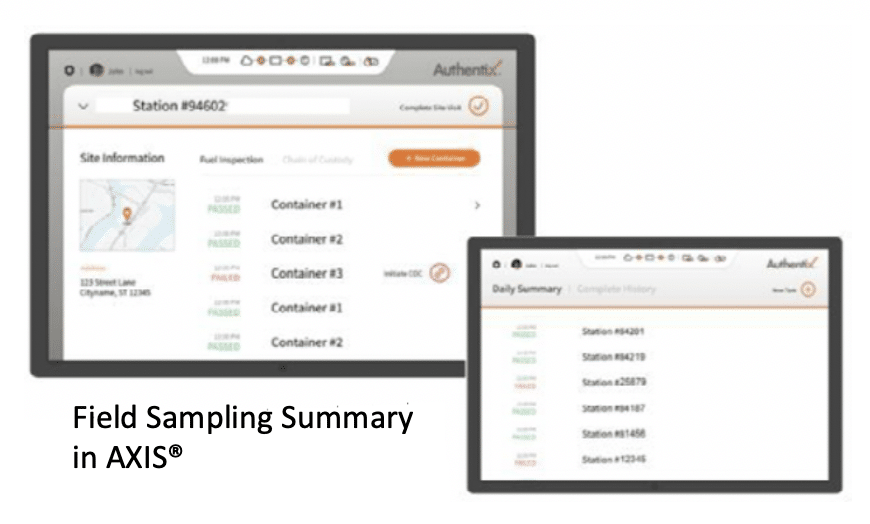
Authentix: Accelerating Digital Transformation for Competitive Advantage
Authentix’s 25 years of industry experience and advanced technology provides customers with a distinct competitive advantage. Our secure marking technology, flexible implementation, proactive program support and actionable insights through the AXIS® platform, help customers thrive in a global economy. For more information, visit authentix.com.
Protecting Critical Care Drugs
|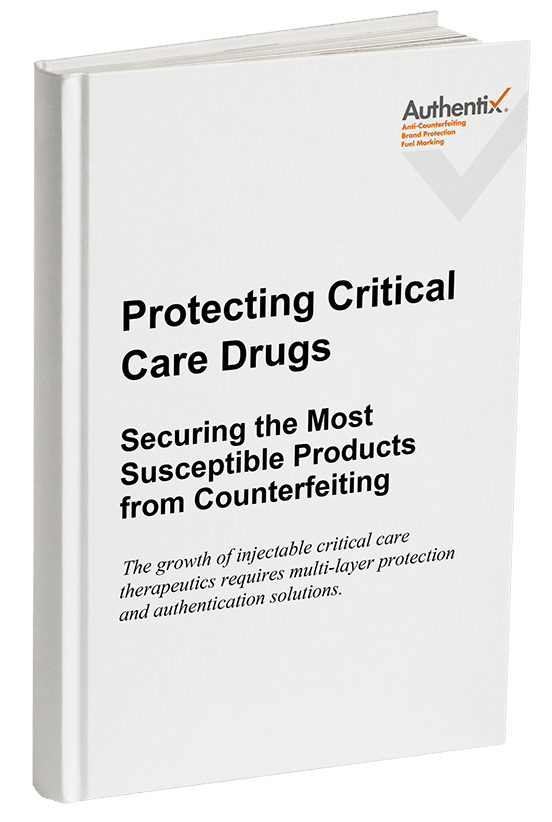 Whitepaper – Protecting Critical Care Drugs
Whitepaper – Protecting Critical Care Drugs
The trafficking of fake and altered drugs, including injectables, has reached epidemic levels in some parts of the world and is a growing problem in the United States.
According to the World Health Organization, 50% of drugs sold online are counterfeit.
What Brand Protection security measures do you have in place to protect your brand against these counterfeit drugs?
In this whitepaper you will learn:
Multi-layered solutions for positive identification
Importance of tracking products through the supply chain
Designs of a proactive, overarching anti-counterfeit strategy
Counterfeiters enter the Legitimate Supply Chain…Your Move for White Paper Download – Thank you
|
THANK YOU!
For your interest in our white paper “Counterfeiters enter the Legitimate Supply Chain…Your Move”
To learn more about how you can act quickly when authenticating a package in the field, visit us here.
Contact us today to speak with an expert.
Risk Assessment Strategy – Thank You
|
THANK YOU!
For your interest in our whitepaper
Authentication in Pharmaceuticals: a 5-Step Risk Assessment Strategy
To learn more about how you can act quickly when authenticating a package in the field, visit us here.
Contact us to speak with an expert today.
Assuring Fuel Integrity from Pipeline to Pump
|By Kevin McKenna, Chief Executive Officer, Authentix
Leveraging Data to Drive Actionable Insights
In a recent survey conducted by Oil & Gas IQ, over 200 downstream industry leaders were asked about the importance of supply chain fuel integrity in delivering on their brand promise. Not surprisingly, 76 percent of respondents said it was very important and 19 percent responded it was somewhat important. Despite the importance of this matter, only 26 percent of the respondents said that they had access to the required data to assure supply chain fuel integrity.
This lack of supply chain data and subsequent corrective and preventative actions exposes brand owners to the ubiquitous risk of fuel manipulation. Fuel manipulation can occur through negligence, system failures, or deliberate illicit acts. Regardless of the cause, when it occurs it can have damaging and lasting effects on consumer confidence and the integrity of branded products – resulting in lost revenue and competitive advantage.
View the full Fuel Quality Industry Report
The Looming Risks of Fuel Manipulation
Many think fuel manipulation isn’t happening in their country or market, or that it is happening at a scale that can be considered part of the cost of doing business, perhaps in the range of five percent of the volume of product sold. Our experience at Authentix is that the volume is typically much higher – in many cases more than 30 percent of the volume of product sold. Petroleum products present a lucrative opportunity for those who wish to deliberately manipulate fuel supplies for their illicit gain. Perpetuating the crime is a simple exercise of price arbitrage – obtain a product at a low price and sell it at a higher price. Lower prices can be obtained from outright theft, subsidized products, smuggling, lower grade products, or adulteration of products with solvents, waste oils, or any low-cost liquid criminals can obtain. This is big business that often goes undetected as represented in a 2017 Ernst & Young report that estimated the illicit fuel market to be $133 billion a year.
Minimize Risks with a Comprehensive Fuel Integrity Program
When a comprehensive fuel integrity program is deployed with sampling, testing, analysis and enforcement, our customers have been able to effectively stop fuel manipulation and achieve returns on investment in many cases of over 10 times. A key tool Authentix uses to combat fuel manipulation and facilitate the tracking and authentication of fuel products is the application of unique chemical markers coupled with proprietary analyzers to detect and measure the markers in the fuel. This lock and key combination of markers and analyzers facilitates the rapid and definitive authentication of products throughout the supply chain – enabling you to detect manipulation from multiple sources. To date, we have marked and protected over two trillion liters of petroleum products across the globe to identify and ameliorate issues such as grade swapping, product adulteration, or quality issues (e.g., incorrect additive dosing, water contamination, etc.).
Over the last few years, we have transformed our solutions to merge the physical authentication results from fuel sampling and testing with ubiquitous data sources (e.g., volume flows, pricing information, truck tracking, etc.) to aggregate and analyze data via the Authentix Information System (AXIS®). AXIS enables our customers to proactively operate their supply and distribution chains for competitive advantage. This transformation has been enabled and accelerated by four ongoing industry trends:
- Increase in data collection, enabled by better connectivity and the Internet of Things (IoT)
- Cheap computing power and cloud infrastructures available
- Improved analysis algorithms and inexpensive machine learning software available
- Excellent open-source software options for data science programming and analysis
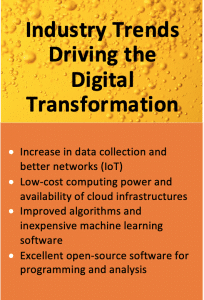
Today we are leveraging cloud architecture, simplifying data collection solutions while accelerating adoption of additional IoT sensors, and investing in proprietary data solutions to increase our ability to provide actionable insights to our customers. AXIS delivers insightful data analytics to isolate anomalies, reveal opportunities for fraud, and identify trends in unauthorized product placement, so you can act to maintain the integrity of the supply chain. By extracting the full value of customer, market, and supply chain data, and combining that with the integrity and responsiveness of our people, our customers gain a significant competitive advantage.
Enabling our customers to thrive in today’s complex supply chains requires more than a chemical marker and a device for measurement. It requires nuanced sector expertise and the means to collect, aggregate, and analyze supply chain data from multiple sources. It requires collaborative partnerships to leverage the growing ecosystem of IoT applications and data sources to deploy solutions quickly, and then learn, adapt, and drive toward predictive analytic solutions built on the AXIS platform. All of this contributes to our vision of creating a world of confident commerce – consumers can be confident they are getting what they pay for, and brand owners are confident they are competing on a level playing field to deliver on their brand promise.
Fuel Quality Industry Report: Downstream Fuel Manipulation
|The threats that could cost you.
Downstream fuel supply chains are more complex than ever and the risks to fuel integrity are serious. Authentix partnered with Oil & Gas IQ to survey industry experts on the impact of downstream fuel manipulation and areas for change.
Doing Business on the Blockchain – Applications for the Lubricant Sector
|Jeff Conroy, Chief Technology Officer, Authentix
Mention blockchain and many people will immediately think of Bitcoin or other cryptocurrencies that have been dominating headlines over the past few years. Although cryptocurrencies are an example of blockchain technology, there are many other uses for the underlying fundamental properties that blockchains provide.
A general definition of blockchain is a distributed, append-only, immutable digital ledger. A blockchain is the connecting (or chaining) of packages of information together in a verified record by a network of users with an agreed upon protocol. This network of users and the record may be publicly available like the well-known cryptocurrencies, or it may be private and require permissions to access like the Hyperledger Fabric that is the basis of many commercially available blockchains for business use.
The protocols in different blockchains may have different advantages for different applications, but the important concept is that the ledger entries (data) are used as the input to a function. That digital data is used as a set of inputs to a protocol (mathematical functions), the output of which is another set of digital data. Once calculated (and validated by multiple parties) the ledger of transaction is updated with the new entries (a new block), and the answer to the function is published (added to the chain). These answers for each block are intertwined in the protocol so that all the past entries and the values calculated for the ledger cannot be changed without a different answer being arrived at by the algorithm. The new blocks would fail to give a correct answer, and nothing would be added to the chain.
The shared possession and processing of the blockchain amongst users acts as a means of instant validation of a historical set of data in that blockchain. No data can go into the blockchain unless it is formatted correctly, processed by the agreed upon protocol, and the new blockchain confirmed by multiple parties as being a valid record given those inputs. In the purely digital world, a blockchain can provide assurance that the all steps taken in a procedure have been undertaken, approved, and immutably recorded for future reference.
However, when we tie a blockchain to the physical world, more elements are needed to ensure a secure record of transactions is produced. While a ledger provides a record of a series of steps or transactions involving digital data, the generation of data such as ASTM test results, API certifications, or volumes of a product shipped between parties must also be done in a way to ensure the data produced is authentic. As in other supply chain solutions, the key is to design the protocol by which the physical to digital transformation of data is robust to accepting falsified data.
In the development of a finished lubricant, a blockchain could be used to carry the complete audit trail in the various production process. For example, the specifications, batch, and quality control results for base materials and additives can be recorded as they are produced according to accredited suppliers’ quality management systems. The procurement of such accredited materials can be tracked, and their use in a blended product verified by the production systems in place at blending facilities. The final QC values of finished goods can be recorded by the approved methods internal to producers or by independent third parties. All information can then be associated with batch, lot, or even individual container identifiers as part of the delivery and distribution process.
With proper physical controls in place, a blockchain can provide a validated audit trail of digital data that would accompany a finished product to verify the authenticity, provenance or properties of the products in the marketplace. When following established protocols for sampling, testing, and distributing physical products, tying a blockchain to a lubricant production process would allow quick verification of compliance. This would replace the disparate information systems, third-party audits and lack of common protocols that make fast and easy validation of materials difficult today.

